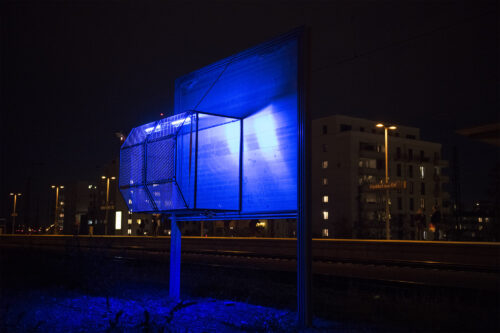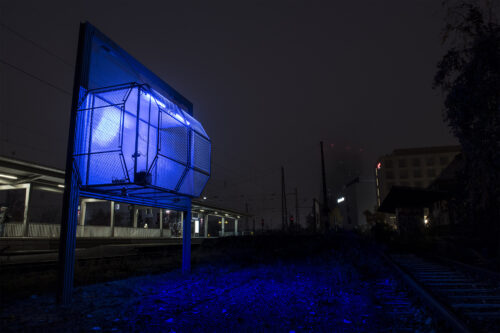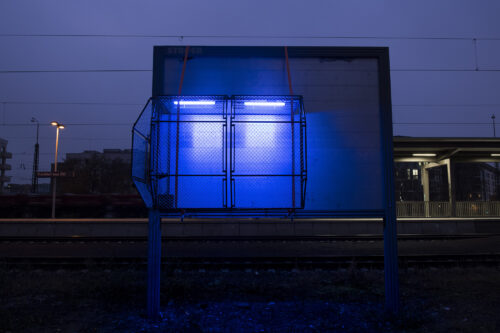From mass advertising to personalized advertising:
the Billboard Cage Project of Christos Voutichtis
Alan N. Shapiro
The billboard is like a theatrical stage. It is an exhibition space, a seductive or informative representation of a product or service or venue, or a simulation drawing attention to itself and becoming its own hyper-reality. It is a large advertising structure on the side of the highway or smack in the middle of the city whose images and words capture the notice of the pedestrian or the motorist moving with speed through the physical world.
A billboard can be blank and waiting for the next commercial customer to rent it and give it new content. It can be illuminated at night by spotlights or have horizontally scrolling neon words that loop endlessly in an electronic display. It might be covered over by graffiti or torn to shreds by vandalism. It might extend outwards with three-dimensional human or animated characters. There exist scented billboards which emit the aroma of a charcoal steak. Billboards operate primarily in the service of the advertising industry.
During the 1960s, the Situationists were an artistic, architectural, and political movement active in major European cities like Paris and London. They were the inheritors of surrealism and Lettrism. They strove towards le dépassement de l’art: the realization of art, its blossoming into a transformative critique of everyday life in the capitalist society. Situationism produced works of radical utopian architecture like Constant Nieuwenhuys’ New Babylon project, a worldwide city of the future, and elaborated the idea of unitary urbanism, the design of a city consisting of endlessly enchanting and participatory non-functionalist situations.
The limits of architecture are the established rules which define its institutional and professional practice. Any project that dares to go past these limits is denied the name of architecture and is relegated to the status of inauthenticity or mere art or pie in the sky. These borders conceal the entanglement of architecture with specific political and economic interests which practitioners are not permitted to transgress.
Yet architecture first and essentially becomes fascinating when it ventures beyond these boundaries. The intellectual act of designing outside of traditional architectural praxis in the form of urban interventions, cyberspace architectonic utopias, or public space exhibitions gains increasing relevance today. These are the concrete sites of an experimental and critical architecture that now expresses itself in both physical and digital/virtual spaces.
The Situationists developed the radical practice of le détournement, a word which has no precise equivalent in English, but means something like diverting, deviating, displacing, rerouting, or hijacking. A billboard advertisement for Marlboro cigarettes is diverted in guerilla style, for example, into an anti-cigarette message by transfiguring the image of the Wyoming cowboy and modifying the text Marlboro to read It’s a bore. Cultural and media expressions of the capitalist system get turned against themselves by altering slogans or images, jamming the messages, twisting them inside out. A meaning emerges at odds with the original intention.
© 2021 Christos Voutichtis
Christos Voutichtis engages in a Situationist practice of le détournement with his Billboard Cage Project intervening in the urban quarter of the main train station of the city of Frankfurt. It is also a practice of architecture that seeks to break free from and overcome architecture’s habitual self-imposed constraints. Voutichtis builds physically a cage-like empty-on-the-inside architectural object in the shape of a rectangular parallelpiped of 224 cm x 150 cm x 112 cm and attaches the constructed artefact to a rather large billboard.
This three-dimensional steel-and-mesh container made with tube rods and polycarbonate chamber plates conforms to the description of a threshold space (Till Boettger) and serves as an exemplar of the genre of interspace art. It is a place at the interstices of regulations, a challenge to prohibitions, and where the defined limits of what is feasible are transcended. The threshold space is a site of freedom, an intermediate zone that becomes a living aesthetic-architectonic commentary on consumerism and the media of advertising.
© 2021 Christos Voutichtis
From the backs of breakfast cereal boxes to giant billboards atop Times Square, from cornea-scanning personalized hologram ad posters as in Steven Spielberg’s film Minority Report to flash graphic animated banners on the World Wide Web, from erotic come-ons on TV to skywritten white letters above the beach that disperse in the blue ether, advertising is the air we breathe. It is a permanent society-wide conversation about consumer commodities.
Advertising is an object in itself that we consume. The dominant culture’s procedure of infinitely generating simulated differences is consummated through advertising. In our relation to advertising, we consume an order of sameness that is concealed beneath the recombinant marginally distinct differences.
Publicity for a specific product is rarely successful – but this is not advertising’s true purpose. Its real and general function is the promotion of the entire system. Without believing in the product, we believe in the advertising that gets us to believe in it. Each product ad refers not only to the individual product that it is informing us about – it also refers to itself, endorsing the wonder of advertising per se.
Through the spectacular celebration or radical visibility of a single object or brand, it is the totality of spectacle objects and a universe made complete by brands that is promoted. In speaking of one object, advertising virtually glorifies all spectacle objects, including all other media images and semiotic signs.
All consumerism is infused with a hyper-visible eroticism. An invisible agency exists somewhere that has taken upon itself the task of informing me of my desires, then generously offering me a non-stop stream of images to satisfy them. Just as alcohol, drugs, gambling, cigarettes, or even ice cream and chocolate provide addictive escapism, so does a permanent flow of images of sexy actresses and models in skimpy clothing. Sexual fantasies are liberated in order to remove me from my own physicality and embodiment.
Women who must measure themselves in relation to media culture’s models of feminine beauty are compelled into a realm of abstraction. They are pressured to conform to socially prescribed standards of female looks and performance in order to attain popularity, success, and positioning as the objects of desire. This brings on dependency on expensive clothes, cosmetics, staying thin and young, and plastic surgery. Moreover, women are encouraged to experience this coercive process of managed narcissism as an act of individual freedom.
The spectacle object – celebrity, consumer gadget, TV series – enters the panoply of fetishes among which we shop in our effort to find an identity niche and dubiously distinguish ourselves from others. The model serves as lightning rod for ambivalent collective projections, allowing each individual to feel unique at the very moment when all consumers of that same niche are imitating the same elevated pattern.
Advertising is constantly bestowing free gifts on us – the unending discounts, sales, gimmicks, contests, sweepstakes, drawings, raffles, lotteries, and giveaways – to buttress the prestige of abundance. All goods are presented as a personal service offered to You. Through advertising, the political-technological order as a whole incorporates you as consumer-citizen. The Prime Directive is on display: “Society adapts itself totally to you and your desires, so integrate yourself totally into society.” The Industrial Revolution took place for your benefit. Modernist Science and Economics have brought good things to life for You.
The ideologies of happiness and growth are correlatively dependent functions of the independent variable of inequality. Growth is a product of the compromise between egalitarian democratic principles and the capitalist order of privilege and domination. To be the carrier of the egalitarian simulation that stands in for an unattainable social equality, happiness must be the hoisted flag of the advertising swindle. All men are equal before the law of Needs and Satisfaction, before the use-value of Objects and Goods. We live in the formal democracy of standards of living and signs of affluence – the Republic of the automobile, the cheeseburger, and the personal computer. Affluence is the accumulation of signs of happiness.
Our version of Abundance is a gift from the gods fallen from the sky, experienced as Manna or the Grace of Nature. The Western consumer is a productive force in the system of Work and Production. It is the Needs of this Order of Production – fabricating and satisfying only the psychological and cultural demands commensurate with it – that get satisfied. Consumer Society is sold to us as the Revolution of the Natural Right to Well-Being – the latest Revolution of Western Man. It is the inheritance to which we are entitled of Technology, Progress, and Freedom. Consumerism is Utopia Realized on Earth.
Washing machine, refrigerator, dishwasher, clothes dryer, hair dryer, wide-screen high-definition TV, Personal Digital Assistant, Personal Voice Companion smart home, smartphone, quadraphonic HiFi, Play Station, game cartridges, audio CDs, video DVDs, sporting goods, exercise equipment, barbeque grill, outdoor furniture – all available here!
Culture is like any other good on sale in the self-enclosed city of the shopping mall. Sample the culinary delights and pursue artistic, intellectual, and spiritual enlightenment. Restaurant, French-Italian cafe, luxury food court and épicerie, cineplex, art gallery, fashion show, bookstore, magazine shop, travel agency, theatre-concert-sports ticket agency, church, meditation center, wellness center.
You can get anything you want – 24 hours a day, 7 days a week, 365 days a year! Pay with your credit card, debit card, Eurocard, store card, gift certificate, cryptocurrency, smartphone swipe or bar code! You are surrounded by Nature in the air-conditioned Megastore that knows no seasons or changes of weather! Palm trees, waterfalls, botanical gardens, chirping aviary, pet shop, sculpted greenery, skylight! The culturalization and naturalization of selling and buying in the Perpetual Shopping of the Super-Shopping Centre!
Consistent with the modernist concept of democracy, the media politics of the EU is rightly concerned with the freedom and pluralism of media content, both of which are essential components of an open and fair society. This way of thinking about the media is crucial for human rights and freedom of information, and for democratic debate and rational consensus.
© 2021 Christos Voutichtis
Yet the public sphere is currently experiencing grave damage and it must be protected in new ways. The public democratic space is suffering degradation from the monopoly consolidation of the control of social media platforms and e-commerce in the hands of a very few large corporations and the business models of those digital platforms. They harvest your personal data and sell it to advertising agencies.
The shift from mass advertising to personalized advertising provides key insights into the paradigm shift in the media from the pre-digital to the digital phase. Prior to digitalization, advertising was a non-personal marketing message not directed at any individual. The mass media as public sphere was a buffer between the source and the target of the sales pitch. Goods and services were offered to the public through announcements in the mass media.
With social media, search engines, mobile and location technologies, facial recognition, artificial neural networks, Deep Learning artificial intelligence, and informatic algorithms, advertisers gain knowledge of identity through collecting the person’s data.
Your browsing, viewing, and buying histories – and your emotions, preferences, and interactions – provide the data for personalized advertising. Companies seize the identity of the consumer, eliminating the public space where citizens previously cultivated their democratic individuality through choosing goods in the marketplace. Political discussion gets similarly damaged – the algorithmic logic of web searches and newsfeeds that shows you more of what you have already seen isolates you in your echo chamber and filter bubble.
Personalized advertising destroys to a significant degree one of the principal arguments in favor of capitalism: the idea that the market is an analogue to the democratic space where you the sovereign individual have the freedom of choice of what to buy. Now the sellers are directly welded to you through Data Science operating on Big Data producing the targeted ad.
Media should function as spaces of communication and mutually respectful dialogue. The European Union should actively support the building of new platforms where citizens can discuss their lives and futures with a spirit of solidarity and social awareness. There should be projects which develop the concept of moral algorithms, where the rules of ethics get coded with reduced discrimination, hate, bullying, racism, sexism, and fake news. We must design a dialogical relationship between human moral-driven institutions/actors and artificial intelligence – and redefine the meaning of the term algorithm to be more anti-automation. There should be game-like virtual worlds that show young people what a better world might look like.
© 2021 Christos Voutichtis
The Billboard Cage Project of Christos Voutichtis is a radical architectural and art in the public space intervention which corresponds in a vital and embodied way to the most profound critiques of the consumer society, the media of advertising, and the society of the spectacle of the most advanced cultural theorists such as Jean Baudrillard and the Situationist Guy Debord. Christos’ project is carried out in the spirit of the concepts of the right to the city and the production of space of the great philosopher of the design of space Henri Lefebvre.
Christos’ cage is a space that contradicts space as we know it. It places into question our assumptions about what architectural space is: the cage offers no warmth or protection, no private sphere or personal safety. It is a space that disregards all human needs. The blue light that is built into the cage causes biological features that make us distinctly human to disappear – our veins are rendered invisible. The cage as space is inhuman. The cage is a commentary on advertising. Advertising is revealed as viscerally inhuman. The cage brings to our awareness the unpleasant truth we do not wish to know. This is the “truth” conveyed by the billboard and Christos’ architectural-artistic extension of it, that advertising truth is a lie, a hyper-lie become truth, a hyper-truth become lie, a hyper-reality beyond the epistemology of truth and lies.
Advertising culture is a prison, a site of confinement and torture, an isolation chamber in the sense of Room 101 as described by George Orwell in the dystopian novel 1984 – a place where one is brought into direct confrontation with one’s worst fears. In 1984, the Ministry of Truth disseminates information, instruction, and entertainment through the two-way telescreens, reaching into all domains of everyday life. Newspeak: the fabricated anti-language, an explicit design accomplished through the elimination of words. Doublethink: the power of holding two contradictory beliefs in one’s mind simultaneously and accepting both of them.
Advertising and consumption developed in America in the 1920s as redesigns of the social landscape in response to intensive labor unrest during the period of rapid capitalist-industrial expansion. Having previously considered workers only from the viewpoint of their productive capacity, managers began to view them as social-psychological beings whose total existence must be contemplated as an arena for influence and control. Today we express our allegiance to the social order in our leisure hours, through media and consumer society. We seek satisfaction in the purchasing of goods rather than in our work life. Advertising is social management that institutes the appearance of a common semiotic belonging to a world of signs.



